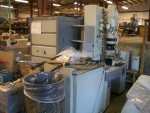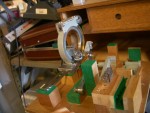November 29, 2004
Carhartt: One brand, two universes
Thanks to my OG Detroit upbringing, I've been familiar with Carhartt clothing for a long time. About 5 years ago I started wearing their dungarees (their term for "work pants") because they fit me better, were a classic design and put me in closer touch with my internal frustrated proletarian laborer. Plus, they look badass. In the US, they're still workers' clothing for the most part: farmers, mechanics, welders, and (in much smaller quantities) greasy Burning Man artists. But in Europe, they've become super chic techno clothing, the physical manifestation of a Roland 303 bassline (all the more appropriate since Carhartt is a Detroit brand, and Detroit's place in the techno mythology of Berlin is huge). After noticing that a lot of their clothing was being shipped to boutiques in Europe and Japan and that it was used as the official hoodie for the last Tricky tour, it looks like someone at Carhartt figured it out and decided to license the name.
Now, knowing that, check out the differences in experience in these two sites:
There's even a boutique in one of the hippest parts of Berlin, complete with graffiti and a Carhartt-branded trick bicycle in the window. Many of my friends there wear Carhartt clothing, but it's nothing like the clothing that the US brand makes.
At first, this seems to be good branding strategy: capitalize on reputation in a market that doesn't provide a lot of revenue by licensing your name to a local. It certainly makes more sense than calling your mayo different names depending on which side of the Mississippi it's being sold on (cf: Hellman's vs. Best Foods; also King Dons vs. Ding Dongs, and snicker if you want to).
Now here's the problem: with such a radical difference, is Carhartt endangering their brand? The coolness of the European brand depends on the stodgy solidity of the US brand, since it's based totally on reference and myth, but the US brand is the bread and butter of the company. Say the European licensee does something stupid, like make a really low-quality product (how good can that bicycle be?) and their name gets trashed in world media. Is that going to completely cause the house of cards to fall, creating confusion among the cash cow US market? Brand resilience isn't infinite. Moreover, fashion being what it is, today's Carhartt is tomorrow's Tommy Gear and next week's Cross Colours. Would being super-duper uncool spill over to the US and if it did, would that be a problem?
I don't know, but it's an interesting question and a good example of brand strategy caught in the wild.
November 28, 2004
Books I recommended at Design Engaged
At Design Engaged we put up Post-Its of books we liked. I put up the following 3 books and decided to share my decisions with everyone, especially now that Christmas is coming up. ;-)
Human-Built World: How to Think About Technology and Culture by Thomas Hughes. A short and awesomely enlightening history and contextualization of where our contemporary attitudes toward technology come from. (Thanks, Mom!)
Imperial San Francisco: Urban Power, Earthly Ruin by Gray Brechin. The Bay Area was the worldwide center of technology innovation before, during the heyday of mining in the 19th century. There's soon going to be a big biotech campus is on the spot where the worldwide center of iron, steel and machinery innovation was happening around 120 years ago. It's intensely instructive to see how the power (literal, in terms of electricity and figurative in terms of influence) related to what, how and why technological advancement happened, and the consequences (it's not surprising that John Muir and modern ecological consciousness happened in Northern California when you see the context). And it's a great read, especially for those who live in SF and the surrounding area.
The Red Queen : Sex and the Evolution of Human Nature by Matt Ridley. A masterful presentation of sex, evolution and how much like birds and the bees we really are. Those who still maintain the Descartian Duality may be surprised as to how much of our behavior is part of a feedback system that's quite obsessed with sex-based competition. All of Matt Ridley's books rock, but this was the first one I read and it's still a big touchstone when I think about human behavior.
[An update: Andrew posted the whole list on his blog. Excellent!]
November 13, 2004
Talking, walking and chewing gum
I'm at Andrew Otwell's Design Engaged conference right now in Amsterdam with a bunch of really great folks. Yesterday I presented with my latest polemic, Talking, walking and chewing gum: the complexity of life and what it means for design. Here's what I said, roughly.
Intro (5 minutes)
Hi. I'm Mike Kuniavsky. I'm wrote a book on user experience research techniques and I co-founded Adaptive Path, a pretty well-known San Francisco consulting company.
Earlier this year I left Adaptive Path and decided to devote some time to thinking about ubiquitous computing and the social effects of technology. And to write polemics, of which this is one.
My thinking about ubicomp, society, technology, and design in general are not unrelated. The material culture around us does not exist in a vacuum. Products are a reflection of social values, and they affect our values, in turn. Objects endowed with information and communication capabilities are a reflection of a set of specific values. They also change our understanding of what an object is, how we relate to it and, in turn, how we relate to all other objects. How many of you have not wanted to do a "Find File" for your keys across your house? I once dreamt of making a symlink in the LA freeway so that I could get from Pasadena to Santa Monica much faster than traversing all of those freeways.
Parallel to all of this line of thought, I've been consulting with large corporations on user-centered design. I started noticing similarities between the problems that they were having, my analysis of the social effects of technology, and what I saw happening elsewhere. So I started making a list of phenomena that seem somehow related. It's a list of things that represent trends I've seen firsthand, and which have been identified as characteristic of our time.
The list
|
Tired: moving away from |
Wired: moving toward |
| Roles | Skills |
| Fast food | Slow food |
| Linear | Emergent |
| Alexander | Koolhaas |
| Dominant Trends | Multiple simultaneous scenarios |
| Supply-driven | Demand-driven |
| Centralized | Distributed |
| Mass production | Mass customization |
| Marketing | User research |
| Policy | Guidelines |
| Waterfall planning | Agile development |
| Picasso | Duchamp |
| Efficiency | Innovation |
| Long future | Short future |
| Sprockets and pulleys | Black boxes and wires |
| Product lines | Customer lines |
| Price | Value |
| Bureaucracy | Federalism |
| Talyor | Peters |
| Utopian futures | Survivable futures |
| Specs | Personas |
| Hierarchical | Flat and social |
Talking and walking (5 minutes)
I look at this collection and try to identify what binds it together. The pattern that appears is a recognition of the complexity of the world, of the unpredictability of the world, of the incomprehensibility of the world, of the contingency of the world, of the time-based, sporadic, overwhelmingly confusing nature of the world.
What I realized while looking at this list is that we are awakening to the fact that the more we know of the world, the more we know how little it follows simple rules. It's all grey area.
To me, this means that the framework of thought of the last 600 years is coming to an end. Renaissance Humanism was the branding of the West's growing dissatisfaction with Catholicism as the main explanation of the workings of the world. The dominant thought that followed is that by dividing the world into small pieces simple laws can be found to explain it. That idea, that way of understanding, is waning. It's been fading for at least 50 years.
Two things have driven this decline: Communication technology and transportation technology. Cheap telephones, televisions, Internet connections, cars and air travel have made information cheap and plentiful. Talking and walking. And all the cheap and plentiful information has done many things, but what it has really done is to show people how complex their world is.
Chewing gum (5 minutes)
Life is incredibly complex, and now it's not just the scientists at the Santa Fe Institute and Wall Street mathematicians who know it. Many people see it and feel it. But most don't know what to do about it. We can see patterns of compensation mechanisms appear. Nihilism, irony, fundamentalism and nostalgia are all ways to simplify the world. We are at the end of the prescriptive rationalist vision of the world and we're waiting for the next framework to explain the world to appear. It has, but it's going to take a while before it's in full bloom. After all, it was 300 years between Giotto and Isaac Newton.
Which brings me to my main point: It is our job as designers to recognize this set of ideas, to understand it, to create for it, and to name it.
Design is a projection of people's values onto the products of technology. Victorian decoration was a celebration of consumer affluence and machinery over the material world. Bauhaus minimalism was a utopian interpretation of products, buildings and people as engineered components. Designers are interpreters, translators, popularizers, and conduits for ideas. We embrace the leading edge and communicate it to the mass market.
We are past the confusion of Postmodernism, which grasped at relativism and then wore out its welcome. We do not live in a relative age, we live in a complex age, but it hasn't been branded yet. It's time for that to change.
However, there's a tendency to think about designing the little problems, but the big context IS important. We are doing ourselves a disservice in the long run by not designing for these ideas. Now is the time for us to embrace complexity through designing for systems, designing metaphors (as Ben and Adam have talked about) flexible tools (that allow for the kind of gardening like what Ben talks about) and, most importantly, designing incentives for people to consciously think about complexity management.
The complexity of the world is an uncomfortably bright light. Most people have found ways to turn away from it. You should not. You are the people who will make the complexity of the world tolerable. Go to the light of complexity. Run to the light!
[I'd like to thank Ben Cerveny for his insight into this over many meals and car drives; the good ideas here are his]
November 09, 2004
More property disposition
Another visit with my family in Michigan means another visit to the University of Michigan's Property Disposition store. I've written about this place before and it's still one of my favorite hometown technology tourist attractions. I decided to take some pictures this time:
The first picture shows shelves of old scientific equipment, the purpose of much of which is lost, maybe to everyone. The third one is a closeup of a piece of measuring equipment that has no manufacturer label, and I have no idea what it's for, but it was probably made before WWII and it is beautifully machined (and it's only $75!). The second picture is of an electron microscope that's only $250, but you have to 1. take it home and 2. figure out how to make it work. Or maybe it can just be a really cool piece of decoration. I'm sure there are some beautiful parts on it. I'd consider buying it, if my parents weren't already on my case for storing that PDP4 in our shed.
Not pictured: the RS/6000 RAID cluster (I guess it's SCSI and had 100 drives in it, adding up to maybe 250GB), $300 (I think), the 1940s Cincinnati lathe ($750), a beautiful IBM mainframe cabinet, with some large mainframe in it ($500?) and an industrial mixer, the most expensive thing I saw because it actually still does something interesting, $1000.
November 06, 2004
The history of the home theater
A nice, short summary of a longer paper by Jeffrey Tang that traces the history of the home theater in the 70s and 80s.
it was not technological breakthroughs, but rather marketing considerations which led to diverse “product families” centered around three types of audio designs: the cassette recorder, the combination unit (“boom box”), and the personal stereo. Both the producers of audio equipment, and audio equipment users assigned new meanings to these sound machines and to the practice of listening to music.[...]
These fields came together when [Dolby] introduced a home version of its 4-channel cinema playback system, called Dolby Surround. Technically, Dolby’s initial system differed little from quadraphonic sound, a technology that had already failed to woo the music lovers of the 1970s. But where quadraphony had failed as a simple technical upgrade to the home stereo, the new system promised not just improved fidelity but an entirely new kind of experience. Its social meaning was dramatically, and successfully, reconstructed.
Technological innovations enable the social innovations, they do not define the whole of them, even though to the participants at the time it may seem to be only about the boxes. The experience is not just about the boxes, and it's not even about the immediate experience (the interface) of the boxes, the experience is created by the boxes, and part of it (the configuring and tweaking the paper mentions and we've all been through) but it's not limited to them. It's a lesson that product designers should keep in mind, though I think there are few techniques for encapsulating or designing for it.
November 02, 2004
The tightening spiral of cool
A surprisingly good report on mesh trucker hats and the ever-shortening cycles of fashion that we've all experienced, from the decidedly unfashionable USA Today (a year ago!).
The cool continuum — that twisty trajectory that traces pop culture from cultish to trendy to mainstream to so-over-it's-embarrassing to, finally, kitsch — is being compressed.
And then there's this interesting paragraph:
Being cool means being the first to yank something out of context and layer on the contradictions. Having money, for instance, is OK if you cloak it in Salvation Army apparel and a shift waiting tables at the local (non-Starbucks) coffee shop. Desk jobs are verboten. The goal? A career in dilettantism.
In Amsterdam I'm going to be talking about how communication and transportation technologies have revealed the complexity of the world to a record number of people in the last 50 years. The understanding that the cycles of the world are really intricate has shifted how people react to the objects and roles (thus the dilletantism) in their world. The last 10 years of have pushed this new understanding--and people's reactions to it--to a new level, aided by cell phones, the Internet and deregulated airplane travel. I think that the decrease in fashion cycles is related to this, and is itself a product of both that understanding and the technologies that created it, so it's interesting to see mainstream (and how much more mainstream than USA Today?) recognition and analysis of the phenomenon.
November 01, 2004
Inkjet printed circuit boards
Seiko Epson Corporation today announced that it has succeeded in leveraging its proprietary inkjet technology to develop ultra-thin 20-layer circuit board.
(from this article)
Nifty! I've read of inkjets being used for all kinds of stuff and this seems like a particularly clever use. Here's an article on printing injet antennas with conductive ink. The injet antenna piece also has a nice story about how innovation happens by accident:
Carclo was working on a way to customize cell phones by printing personal images on the plastic bodies, when it ran into a problem trying to print Motorola’s silver metallic logo.[...]
Carclo developed a prototype printer that's about the size of a small photocopier. It can print copper antennas on polycarbonate, polyester, polyethylene and other plastic films used for RFID tags, as well as on paper and cardboard. The copper layer can be as thin as half a micron and is almost as conductive as a solid copper antenna. And unlike bulk metal antennas, the printed antenna is recyclable.
I wonder if any of the check printing magnetic inks have enough conductivity to be usable for home-grown circuit printing...
Between these two technologies and the various other printer-based technologies (such as the polyester rapid prototyping rigs that are another kind of inkjet printer), I wonder how long before whole electronic devices can be printed on demand?


